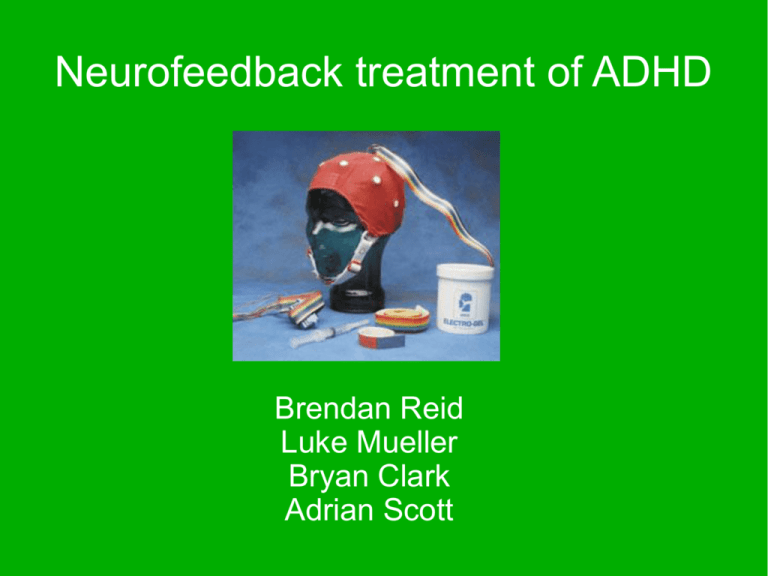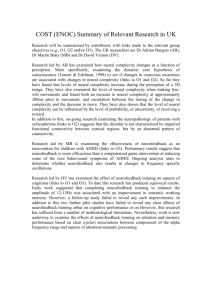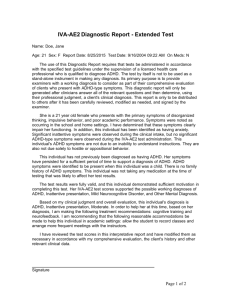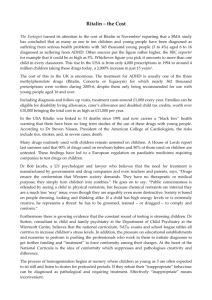Neurofeedback treatment of ADHD
advertisement

Neurofeedback treatment of ADHD Brendan Reid Luke Mueller Bryan Clark Adrian Scott Outline ● What is ADHD? ● Physiology and Neurofeedback Procedures ● 2 Efficacy Studies ● Criticism of Neurofeedback for ADHD treatment What is ADHD ● ● A medical condition caused by genetic factors that result in certain neurological differences Behavioral Characteristics 1. Problems with attention 2. Lack of Impulse Control 3. Motor Restlessness 4. Boredom ● Classifications >Inattentive >Impulsive-Hyperactive Timeline Names Drugs Is ADHD on the Rise? ● ● Market flooded with new drugs Number of legitimate cases has remained steady – – ● 5% in adults 3% in children Misdiagnosis – – – Drug exposure in-utero Fetal Alcohol Syndrome(FAS) Expectant Mothers: ● ● ~5% report using illicit drugs* >20% report using alcohol* *Source: National Institute of Drug Abuse (NIDA) “Dr. Quack’s Machine” Development of Neurofeedback Therapy for ADHD (I) ● ● Dr. Barry Sternan – Commisioned by U.S. Navy – Training experiments on cats D.A. Quirk – Showed interesting neurofeedback results with prisoners – First to test effectiveness at treating ADHD, as well as neurological disorders ● ● ● Depression Autism Stroke Neurometric Analysis Development of Neurofeedback Therapy for ADHD ● (II) Able to distinguish Learning Disabled from nonLearning Disabled children based on EEG differences ● 97% successful diagnosis? ● High Hopes – “Should be possible to use home computers…to carry out neurometric analysis right in the schools” Brain waves and their functions ● Delta: 0.1-3 Hz ● Deep sleep, lucid dreaming, increased immune functions, hypnosis Theta: 3-8 Hz ● Deep relaxation, meditation, increased memory, focus, creativity, lucid dreaming Alpha: 8-12 Hz ● Light relaxation, “super learning”, positive thinking Low Beta: 12-15 Hz ● Relaxed focus, improved attentive abilities Midrange Beta: 15-18 Hz – – – – – ● High Beta: above 18Hz – ● Increased mental ability, focus, alertness, and IQ Fully awake, normal state of alertness, stress and anxiety Gamma: 40 Hz – Associated with information-rich task processing and high-level information processing Brainwaves in ADHD children ● Lubar suggested that children with hyperactivity + an attention deficit have: – – ● Less beta activity above 14 Hz Excessive theta (4-8 Hz) activity Suggests that these children are less able to shift from resting states (theta/alpha dominant) to excited states (beta dominant) Brainwaves in ADHD children ● ● A case study of 6 such patients showed that SMR (12-15 Hz) training followed by beta training with theta inhibition produced significant and sustained improvements in school performance and psychometric measures Letter grades improves, and SMR and beta production improved with decreases in theta What areas/systems are affected in ADHD patients? ● Frontal lobe – – – – – – Attention to tasks Focus concentration Make good decisions Plan ahead Learn and remember what we have learned Behave appropriately in situations What areas/systems are affected in ADHD patients? ● Limbic system – – – Base of our emotions If over-activated, a person might have wide mood swings or quick temper outbursts Might also be “over-aroused”: quick to startle, touching everything around, hyper vigilant What areas/systems are affected in ADHD patients? ● The Reticular Activating System – – – – Connected at its base to the spinal cord Receives information projected directly from the ascending sensory tracts Brainstem reticular formation runs all the way up to the mid-brain Serves as a point of convergence for signals from the external world and from interior environment What areas/systems are affected in ADHD patients? ● Functional imaging techniques have pointed to 3 areas related to the basal ganglia – – – ● Prefrontal cortex Caudate nucleus Globus palladus Problems with the circuit between these three regions may be the underlying mechanism that causes ADHD symptoms EEG Biofeedback procedure ● One or more sensors are put on the scalp and one on an earlobe No pain – Non-invasive Computer translates brainwaves into controls for a video game – ● Practice can allow the child to gain an increased control over their brainwaves Number of sessions varies – ● – Can take from 40-60 sessions to eliminate ADD, may need more than 60 for ADHD Two Efficacy Studies ● Monastra et al. (2002) study ● Fuchs et al. (2003) study Monastra et al (2002) ● ● ● ● 100 subjects (mean age = 10) were diagnosed with ADHD using multiple tests All subjects were given stimulant therapy, parental counseling, and school consultation 51 of the subjects were administered neurofeedback Subjects were tested after 1 year, then taken off Ritalin for 1week and retested Monastra: Detail of neurofeedback training ● ● ● ● 30-40 minute weekly sessions “point” given for each .5 seconds of improved arousal 20 points could be exchanged for a $15 reward Children were given training until their cortical slowing was within 1 SD of same-age peers Monastra Results ● Tested after 1 year of medication with Ritalin, then 1 week later after no Ritalin – Non-neurofeedback group showed little improvement over their initial scores while on Ritalin, no improvement after the wash-out period; all still classified as ADHD – Neurofeedback group showed significant improvement; most were no longer classified as ADHD – Of the neurofeedback group, the only subgroup that still tested as ADHD were subjects who received non-systematic parenting Monastra: Results Fuchs et al. (2003) ● 34 children (mean age=9.8) diagnosed with ADHD but not previously treated – – – Treatment based on parent's choice 22 given neurofeedback (no Ritalin) 12 given Ritalin ● ● Typically 3 10-mg doses, only on school days Treatment lasted for 12 weeks – One subject in the Ritalin group dropped out because of excessive side effects (tics) Fuchs: Detail of Neurofeedback Training ● Neurofeedback training to increase 12-18 Hz activity, decrease 4-7 Hz and 22-30 Hz – – – Children of the hyperactive subtype were trained in SMR (12-15 Hz) Children of the inattentive subtype were trained in beta1 (15-18) Hz activity Children of the combined subtype were trained for half the sessions in SMR, half the sessions in beta1 Fuchs: Detail of Neurofeedback Training ● SMR is associated with inhibition of the thalamo-cortical loop – ● Hyperactivity is thought to be caused by overresonsiveness in the right hemisphere, so suppressing activity would lead to an decrease in hyperactivity Attentional deficits may be caused by a predominance of theta and lack of beta activity in the left hemisphere Fuchs: Results ● ● No difference between groups pre-treatment After treatment, both groups showed similar improvements on all tests Problems with Neurofeedback ● ● ● ● ● ● time and money (at least 40 sessions, up to $100 each) insurance doesn't cover neurofeedback requires patient to be motivated, bored patients not as successful age: too young vs too old (somewhat individual) *ability to make EEG changes* Unreliable success rate (~50% --> ~90%), uncertainty of effectiveness until late in treatment Criticism: “Hunters in a Farmer’s World” (Genetic basis of ADHD) ● ● ● ● ● cultural evolution v.s. biological evolution AD/HD may not have always been a disorder (University of California, Irvine) Attention-Deficit/Hyperactivity Disorder (AD/HD) first appeared 10,000 to 40,000 years ago speculation that early humans with AD/HD had traits such as novelty-seeking, increased aggression and perseverance traits have been associated with the DRD4 7R gene Hunters in a Farmer’s World (cont.) ● ● ● ● ● "survival of the fittest" scenario ever-increasing number of people with AD/HD more aggressive, inquisitive, and willing to take risks meant a higher probability for mate selection and perhaps multiple sex partners spreading of the gene – and its associated AD/HD behaviors – through the population. Primitive hunters with this gene would have been more successful and would have been better providers for their families and tribes Criticism: Incomplete Knowledge ● ● ● Incomplete understanding of underlying mechanisms of brain wave production Is it wise to alter these mechanism by using their byproduct? Self directed alteration and morality. Are unknown or intractable side effects in action? ● Placebo effect (up to 50%) ● Reproducible results: Umbrella Diagnosis ● Symptoms: cause or effect? Criticism: Afterwards ● Potentially permanent changes (side effects may be more intractable, like loss of creativity) ● Personality changes ● Standardization of behavior ● Long term effects relatively unstudied ● Technology advancement and future uses Neuroscience conference on Neurofeedback (UCLA, 2005) ● Widespread support from clinical practitioners ● Skepticism from researchers ● “Scale Chauvinism” ● Unconvinced vs Under-funded ● ● Neurofeedback as alternatives to Psychostimulants Double blind studies and Placebo effect Neurofeedback, ADHD, and Altered States of Consciousness ● ● If states of consciousness are dependent on brain activity, then the mental states of an untreated ADHD patient are different from their treated mental states (since there is a change in EEG readings) ADHD has effects on dopamine, norepinepherine, acetylcholine References ● ● ● Masterpasqua, Frank and Kathryn Healey. “Neurofeedback in Psychological Practice. Professional Psychology: Research and Practice”. 2003, Vol. 34, No. 6, 652-656. Fuchs, Thomas et al. “Neurofeedback for Attention-Deficit/Hyperactivity Disorder in Children: A Comparison With Methylphenidate”. Applied Psychophysiology and Biofeedback, Vol. 28, No. 1, March 2003. Monastra, Vincent, Donna Monastra, and Susan George. “The effects of Stimulant Therapy, EEG Biofeedback, and Parenting Style on the Primary Symptoms of Attention-Deficit/Hyperactivity Disorder.” Applied Psychophysiology and Biofeedback, Vol. 27, No. 4, Dec. 2002. ● http://www.drbiofeedback.com/sections/biofeedback/howisbioperformed.html ● http://www.newideas.net/attention_deficit/neurology.htm ● http://brain.web-us.com/brainwavesfunction.htm References (cont.) ● Lubar Joel F. (1985) EEG Biofeedback and Learning Disabilities Theory Into Practice, 24(2) 106-111. ● (2003) "The History of ADHD and Attention Deficit Disorder" May 20, 2005. ● http://www.add-adhd-help-center.com/newsletters/newsletter_15july03.htm ● Bate P (2004) Brief History of EEG Biofeedback May 20, 2005 ● http://www.adhd-biofeedback.com/eeghist.html ● http://www.add-adhd.org/ADHD_attention-deficit.html ● http://www.adhd.com.au/Neuro.html ● http://www.attention.com/start/New_Abstracts.pdf ● http://www.eegspectrum.com/Applications/ADHD-ADD/EfficacySMR-BetaIntro2/








